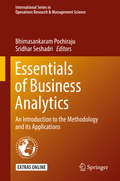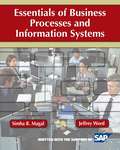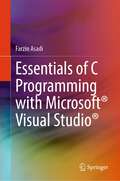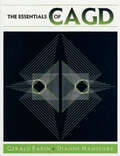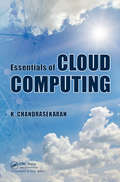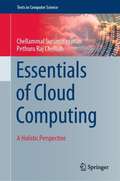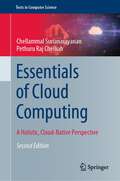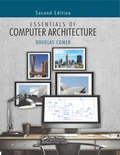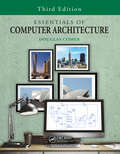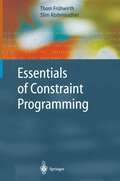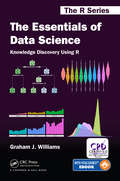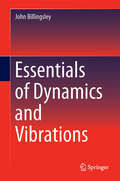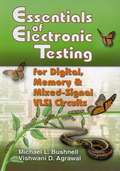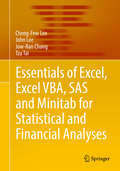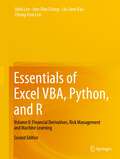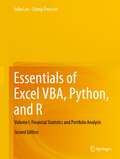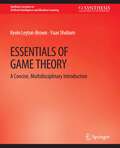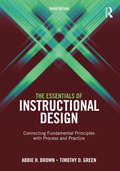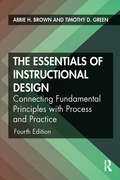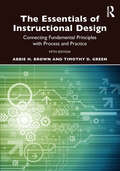- Table View
- List View
Essentials of Business Analytics: An Introduction to the Methodology and its Applications (International Series in Operations Research & Management Science #264)
by Bhimasankaram Pochiraju Sridhar SeshadriThis comprehensive edited volume is the first of its kind, designed to serve as a textbook for long-duration business analytics programs. It can also be used as a guide to the field by practitioners. The book has contributions from experts in top universities and industry. The editors have taken extreme care to ensure continuity across the chapters.The material is organized into three parts: A) Tools, B) Models and C) Applications. In Part A, the tools used by business analysts are described in detail. In Part B, these tools are applied to construct models used to solve business problems. Part C contains detailed applications in various functional areas of business and several case studies. Supporting material can be found in the appendices that develop the pre-requisites for the main text. Every chapter has a business orientation. Typically, each chapter begins with the description of business problems that are transformed into data questions; and methodology is developed to solve these questions. Data analysis is conducted using widely used software, the output and results are clearly explained at each stage of development. These are finally transformed into a business solution. The companion website provides examples, data sets and sample code for each chapter.
Essentials of Business Processes and Information Systems
by Simha R. Magal Jeffrey WordThis supplement text bridges the gap between the fundamentals of how businesses operate (processes) and the tools that business people use to accomplish their tasks (systems). The authors have developed this text for an introductory MIS or general business course to establish a fundamental understanding of business processes. Business students, regardless of their functional discipline, will be able to apply the real-world concepts discussed in this text immediately upon entering the workforce. As more and more businesses adopt enterprise systems globally, it becomes increasingly important for business schools to offer a process-based curriculum to better reflect the realities of modern business. Given the integration of business operations and enterprise systems, Magal and Word have designed this text to reflect, in a practical and accessible format, how real-world business processes are managed and executed.
Essentials of C Programming with Microsoft® Visual Studio®
by Farzin AsadiThis book provides a compact but comprehensive treatment that guides readers through the C programming language with Microsoft® Visual Studio®. The author uses his extensive classroom experience to guide readers toward deeper understanding of key concepts of the C language. Each concept and feature of the language is presented as a short lesson, illustrated by practical worked examples to aid student self study. The book will appeal to a broad range of students who are required to study the C programming language.
The Essentials of CAGD
by Gerald Farin Dianne HansfordPutting the G into CAGD, the authors provide a much-needed practical and basic introduction to computer-aided geometric design. This book will help readers understand and use the elements of computer-aided geometric design, curves and surfaces, without the mathematical baggage that is necessary only for more advanced work. Though only minimal backg
Essentials of Cloud Computing
by K. ChandrasekaranCloud computing-accessing computing resources over the Internet-is rapidly changing the landscape of information technology. Its primary benefits compared to on-premise computing models are reduced costs and increased agility and scalability. Hence, cloud computing is receiving considerable interest among several stakeholders-businesses, the IT ind
Essentials of Cloud Computing: A Holistic Perspective (Texts in Computer Science)
by Chellammal Surianarayanan Pethuru Raj ChelliahThis reader-friendly textbook presents a comprehensive overview of the essential aspects of cloud computing, from the origin of the field to the latest developments. Rather than merely discussing the cloud paradigm in isolation, the text also examines how cloud computing can work collaboratively with other computing models to meet the needs of evolving computing trends. This multi-dimensional approach encompasses the challenges of fulfilling the storage requirements of big data, the use of the cloud as a remote server for Internet of Things and sensor networks, and an investigation of how cloud computing is interlinked with edge, fog and mist computing, among other illuminating perspectives.Topics and features: includes learning objectives, motivating questions, and self-test exercises in every chapter; presents an introduction to the underlying concepts, fundamental features, and key technological foundations of cloud computing; examines how enterprise networking and cloud networking can work together to achieve business goals; reviews the different types of cloud storage available to address the evolution of data and the need for digitization; discusses the challenges and approaches to implementing cloud security, and the hot topic of cloud management; highlights the value of cloud brokerage capabilities, and explains the importance of cloud orchestration in multi-cloud environments; describes the details of cloud migration, the crucial role of monitoring in optimizing the cloud, and the basics of disaster recovery using cloud infrastructure.This technically rigorous yet simple-to-follow textbook is an ideal resource for graduate courses on cloud computing. Professional software developers and cloud architects will also find the work to be an invaluable reference.
Essentials of Cloud Computing: A Holistic, Cloud-Native Perspective (Texts in Computer Science)
by Chellammal Surianarayanan Pethuru Raj ChelliahNumerous advancements are being brought in and incorporated into the cloud domain with the aim of realizing a trove of deeper and decisive automations.Rather than discussing the cloud paradigm in isolation, this fully updated text examines how cloud computing can work collaboratively with other computing models to meet the needs of evolving trends.This multi-dimensional approach encompasses the challenges of fulfilling the storage requirements of big data, the use of the cloud as a remote server for Internet of Things and sensor networks, and an investigation of how cloud computing is interlinked with other established computing phenomenon such as edge computing. New chapters illustrate the distinct ideals of the cloud-native computing, proclaimed as the next-generation cloud computing paradigm.Topics and features:Includes learning objectives, motivating questions, and self-test exercisesIntroduces the underlying concepts, fundamental features, and key technological foundations of cloud computingExamines how enterprise networking and cloud networking can work together to achieve business goalsReviews the different types of cloud storage available to address the evolution of data and the need for digitizationDiscusses the challenges and approaches to implementing cloud governance, security, and the hot topic of cloud managementDescribes the details of cloud migration, the crucial role of monitoring in optimizing the cloud, and the basics of disaster recovery using cloud infrastructureThis technically rigorous, yet simple-to-follow textbook is an ideal resource for graduate courses on cloud computing. Professional software developers and cloud architects will also find the work to be an invaluable reference.
Essentials of Computer Architecture
by Douglas ComerThis easy to read textbook provides an introduction to computer architecture, while focusing on the essential aspects of hardware that programmers need to know. The topics are explained from a programmer’s point of view, and the text emphasizes consequences for programmers. Divided in five parts, the book covers the basics of digital logic, gates, and data paths, as well as the three primary aspects of architecture: processors, memories, and I/O systems. The book also covers advanced topics of parallelism, pipelining, power and energy, and performance. A hands-on lab is also included. The second edition contains three new chapters as well as changes and updates throughout.
Essentials of Computer Architecture
by Douglas ComerThis easy-to-read textbook provides an introduction to computer architecture, focusing on the essential aspects of hardware that programmers need to know. Written from a programmer’s point of view, Essentials of Computer Architecture, Third Edition, covers the three key aspects of architecture: processors, physical and virtual memories, and input-output (I/O) systems.This third edition is updated in view of advances in the field. Most students only have experience with high-level programming languages, and almost no experience tinkering with electronics and hardware. As such, this text is revised to follow a top-down approach, moving from discussions on how a compiler transforms a source program into binary code and data, to explanations of how a computer represents data and code in binary.Additional chapters cover parallelism and data pipelining, assessing the performance of computer systems, and the important topic of power and energy consumption. Exclusive to this third edition, a new chapter explains multicore processors and how coherence hardware provides a consistent view of the values in memory even though each core has its own cache.Suitable for a one-semester undergraduate course, this clear, concise, and easy-to-read textbook offers an ideal introduction to computer architecture for students studying computer programming.
Essentials of Computer Architecture
by Douglas ComerThis easy-to-read textbook provides an introduction to computer architecture, focusing on the essential aspects of hardware that programmers need to know. Written from a programmer’s point of view, Essentials of Computer Architecture, Third Edition, covers the three key aspects of architecture: processors, physical and virtual memories, and input-output (I/O) systems.This third edition is updated in view of advances in the field. Most students only have experience with high-level programming languages, and almost no experience tinkering with electronics and hardware. As such, this text is revised to follow a top-down approach, moving from discussions on how a compiler transforms a source program into binary code and data, to explanations of how a computer represents data and code in binary.Additional chapters cover parallelism and data pipelining, assessing the performance of computer systems, and the important topic of power and energy consumption. Exclusive to this third edition, a new chapter explains multicore processors and how coherence hardware provides a consistent view of the values in memory even though each core has its own cache.Suitable for a one-semester undergraduate course, this clear, concise, and easy-to-read textbook offers an ideal introduction to computer architecture for students studying computer programming.
Essentials of Constraint Programming (Cognitive Technologies)
by Thom Frühwirth Slim AbdennadherThe use of constraints had its scientific and commercial breakthrough in the 1990s. Programming with constraints makes it possible to model and specify problems with uncertain, incomplete information and to solve combi natorial problems, as they are abundant in industry and commerce, such as scheduling, planning, transportation, resource allocation, layout, design, and analysis. This book is a short, concise, and complete presentation of constraint programming and reasoning, covering theoretical foundations, algorithms, implementations, examples, and applications. It is based on more than a decade of experience in teaching and research about this subject. This book is intended primarily for graduate students, researchers, and practitioners in diverse areas of computer science and related fields, including programming languages, computational logic, symbolic computation, and ar tificial intelligence. The book is complemented by a web-page with teaching material, software, links, and more. We take the reader on a step-by-step journey through the world of constraint-based programming and constraint reasoning. Feel free to join in ... Acknowledgements Thorn thanks his wife Andrea and his daughter Anna - for everything. He dedicates his contribution to the book to the memory of his mother, Grete. Slim thanks his wife N abila and his daughters Shirine and Amira for their ongoing support and patience.
The Essentials of Data Science: Knowledge Discovery Using R (Chapman & Hall/CRC The R Series)
by Graham J. WilliamsThe Essentials of Data Science: Knowledge Discovery Using R presents the concepts of data science through a hands-on approach using free and open source software. It systematically drives an accessible journey through data analysis and machine learning to discover and share knowledge from data.Building on over thirty years’ experience in teaching and practising data science, the author encourages a programming-by-example approach to ensure students and practitioners attune to the practise of data science while building their data skills. Proven frameworks are provided as reusable templates. Real world case studies then provide insight for the data scientist to swiftly adapt the templates to new tasks and datasets. The book begins by introducing data science. It then reviews R’s capabilities for analysing data by writing computer programs. These programs are developed and explained step by step. From analysing and visualising data, the framework moves on to tried and tested machine learning techniques for predictive modelling and knowledge discovery. Literate programming and a consistent style are a focus throughout the book.
The Essentials of Data Science: Knowledge Discovery Using R (Chapman & Hall/CRC The R Series)
by Graham J. WilliamsThe Essentials of Data Science: Knowledge Discovery Using R presents the concepts of data science through a hands-on approach using free and open source software. It systematically drives an accessible journey through data analysis and machine learning to discover and share knowledge from data.Building on over thirty years’ experience in teaching and practising data science, the author encourages a programming-by-example approach to ensure students and practitioners attune to the practise of data science while building their data skills. Proven frameworks are provided as reusable templates. Real world case studies then provide insight for the data scientist to swiftly adapt the templates to new tasks and datasets. The book begins by introducing data science. It then reviews R’s capabilities for analysing data by writing computer programs. These programs are developed and explained step by step. From analysing and visualising data, the framework moves on to tried and tested machine learning techniques for predictive modelling and knowledge discovery. Literate programming and a consistent style are a focus throughout the book.
Essentials of Dynamics and Vibrations
by John BillingsleyDynamic objects move in mysterious ways. Their analysis is a difficult subject involving matrices, differential equations and the complex algebra of oscillatory systems. However, in this textbook, the author draws on his long experience of designing autopilots, robots for nuclear inspection and agricultural machine guidance to present the essentials with a light touch. The emphasis is on a deep understanding of the fundamentals rather than rote-learning of techniques. The inertia tensor is presented as a key to understanding motion ranging from boomerangs to gyroscopes. Chains of transformations unravel the motion of a robot arm.To help the reader visualise motion, ranging from unbalanced rotors to vibrating systems with multiple modes and damping, there are abundant simulation examples on a linked website. These will run in any web browser, while their simple code is on open view for modification and experimentation. They show that nonlinear systems present no problems, so that friction damping can be modelled with ease. A particular problem for mechanical engineers is that the vibration topics encroach on the territory of the electrical engineer. State variables open up control theory while the solution of differential equations with sinusoidal inputs is simplified by an understanding of sine-waves as complex exponentials. The linked web site has several areas of mathematics revision to help. A final chapter pokes fun at the misrepresentation of dynamics in cinema productions.
Essentials of Electronic Testing for Digital, Memory and Mixed-Signal VLSI Circuits (Frontiers in Electronic Testing #17)
by M. Bushnell Vishwani AgrawalThe modern electronic testing has a forty year history. Test professionals hold some fairly large conferences and numerous workshops, have a journal, and there are over one hundred books on testing. Still, a full course on testing is offered only at a few universities, mostly by professors who have a research interest in this area. Apparently, most professors would not have taken a course on electronic testing when they were students. Other than the computer engineering curriculum being too crowded, the major reason cited for the absence of a course on electronic testing is the lack of a suitable textbook. For VLSI the foundation was provided by semiconductor device techn- ogy, circuit design, and electronic testing. In a computer engineering curriculum, therefore, it is necessary that foundations should be taught before applications. The field of VLSI has expanded to systems-on-a-chip, which include digital, memory, and mixed-signalsubsystems. To our knowledge this is the first textbook to cover all three types of electronic circuits. We have written this textbook for an undergraduate “foundations” course on electronic testing. Obviously, it is too voluminous for a one-semester course and a teacher will have to select from the topics. We did not restrict such freedom because the selection may depend upon the individual expertise and interests. Besides, there is merit in having a larger book that will retain its usefulness for the owner even after the completion of the course. With equal tenacity, we address the needs of three other groups of readers.
Essentials of Excel, Excel VBA, SAS and Minitab for Statistical and Financial Analyses
by Cheng-Few Lee John Lee Jow-Ran Chang Tzu TaiThis introductory textbook for business statistics teaches statistical analysis and research methods via business case studies and financial data using Excel, Minitab, and SAS. Every chapter in this textbook engages the reader with data of individual stock, stock indices, options, and futures. One studies and uses statistics to learn how to study, analyze, and understand a data set of particular interest. Some of the more popular statistical programs that have been developed to use statistical and computational methods to analyze data sets are SAS, SPSS, and Minitab. Of those, we look at Minitab and SAS in this textbook. One of the main reasons to use Minitab is that it is the easiest to use among the popular statistical programs. We look at SAS because it is the leading statistical package used in industry. We also utilize the much less costly and ubiquitous Microsoft Excel to do statistical analysis, as the benefits of Excel have become widely recognized in the academic world and its analytical capabilities extend to about 90 percent of statistical analysis done in the business world. We demonstrate much of our statistical analysis using Excel and double check the analysis and outcomes using Minitab and SAS—also helpful in some analytical methods not possible or practical to do in Excel.
Essentials of Excel VBA, Python, and R: Volume II: Financial Derivatives, Risk Management and Machine Learning
by John Lee Jow-Ran Chang Lie-Jane Kao Cheng-Few LeeThis advanced textbook for business statistics teaches, statistical analyses and research methods utilizing business case studies and financial data with the applications of Excel VBA, Python and R. Each chapter engages the reader with sample data drawn from individual stocks, stock indices, options, and futures. Now in its second edition, it has been expanded into two volumes, each of which is devoted to specific parts of the business analytics curriculum. To reflect the current age of data science and machine learning, the used applications have been updated from Minitab and SAS to Python and R, so that readers will be better prepared for the current industry.This second volume is designed for advanced courses in financial derivatives, risk management, and machine learning and financial management. In this volume we extensively use Excel, Python, and R to analyze the above-mentioned topics. It is also a comprehensive reference for active statistical finance scholars and business analysts who are looking to upgrade their toolkits. Readers can look to the first volume for dedicated content on financial statistics, and portfolio analysis.
Essentials of Excel VBA, Python, and R: Volume I: Financial Statistics and Portfolio Analysis
by John Lee Cheng-Few LeeThis advanced textbook for business statistics teaches, statistical analyses and research methods utilizing business case studies and financial data, with the applications of Excel VBA, Python and R. Each chapter engages the reader with sample data drawn from individual stocks, stock indices, options, and futures. Now in its second edition, it has been expanded into two volumes, each of which is devoted to specific parts of the business analytics curriculum. To reflect the current age of data science and machine learning, the used applications have been updated from Minitab and SAS to Python and R, so that readers will be better prepared for the current industry.This first volume is designed for advanced courses in financial statistics, investment analysis and portfolio management. It is also a comprehensive reference for active statistical finance scholars and business analysts who are looking to upgrade their toolkits. Readers can look to the second volume for dedicated content on financial derivatives, risk management, and machine learning.
Essentials of Game Theory: A Concise Multidisciplinary Introduction (Synthesis Lectures on Artificial Intelligence and Machine Learning)
by Kevin Gebser Yoav KaminskiGame theory is the mathematical study of interaction among independent, self-interested agents. The audience for game theory has grown dramatically in recent years, and now spans disciplines as diverse as political science, biology, psychology, economics, linguistics, sociology, and computer science, among others. What has been missing is a relatively short introduction to the field covering the common basis that anyone with a professional interest in game theory is likely to require. Such a text would minimize notation, ruthlessly focus on essentials, and yet not sacrifice rigor. This Synthesis Lecture aims to fill this gap by providing a concise and accessible introduction to the field. It covers the main classes of games, their representations, and the main concepts used to analyze them.
The Essentials of Instructional Design: Connecting Fundamental Principles with Process and Practice, Third Edition
by Abbie H. Brown Timothy D. GreenThe Essentials of Instructional Design, 3rd Edition introduces the essential elements of instructional design (ID) to students who are new to ID. The key procedures within the ID process—learner analysis, task analysis, needs analysis, developing goals and objectives, organizing instruction, developing instructional activities, assessing learner achievement and evaluating the success of the instructional design—are covered in complete chapters that describe and provide examples of how the procedure is accomplished using the best known instructional design models. Unlike most other ID books, The Essentials of Instructional Design provides an overview of the principles and practice of ID without placing emphasis on any one ID model. Offering the voices of instructional designers from a number of professional settings and providing real-life examples from across sectors, students learn how professional organizations put the various ID processes into practice. This introductory textbook provides students with the information they need to make informed decisions as they design and develop instruction, offering them a variety of possible approaches for each step in the ID process and clearly explaining the strengths and challenges associated with each approach.
The Essentials of Instructional Design: Connecting Fundamental Principles with Process and Practice, Third Edition
by Abbie H. Brown Timothy D. GreenThe Essentials of Instructional Design, 3rd Edition introduces the essential elements of instructional design (ID) to students who are new to ID. The key procedures within the ID process—learner analysis, task analysis, needs analysis, developing goals and objectives, organizing instruction, developing instructional activities, assessing learner achievement and evaluating the success of the instructional design—are covered in complete chapters that describe and provide examples of how the procedure is accomplished using the best known instructional design models. Unlike most other ID books, The Essentials of Instructional Design provides an overview of the principles and practice of ID without placing emphasis on any one ID model. Offering the voices of instructional designers from a number of professional settings and providing real-life examples from across sectors, students learn how professional organizations put the various ID processes into practice. This introductory textbook provides students with the information they need to make informed decisions as they design and develop instruction, offering them a variety of possible approaches for each step in the ID process and clearly explaining the strengths and challenges associated with each approach.
The Essentials of Instructional Design: Connecting Fundamental Principles with Process and Practice
by Abbie H. Brown Timothy D. GreenThe Essentials of Instructional Design, 4th Edition, introduces the fundamental elements, principles, and practice of instructional design (ID) to students new to ID. Key procedures within the ID process—learner analysis, task analysis, needs analysis, developing goals and objectives, organizing instruction, developing instructional activities, assessing learner achievement, and evaluating the success of the instructional design—are covered comprehensively and enriched with descriptions and examples of how these procedures are accomplished using the best-known models. Unlike most other ID books, The Essentials of Instructional Design provides an overview of the principles and practice of ID without placing emphasis on any one ID model. Offering the voices of instructional designers from a number of professional settings and providing real-life examples from across sectors, students learn how professional organizations put the various ID processes into practice. This revised edition features new activities, quizzes, and content on professional development. Offering a variety of possible approaches for each step in the ID process and clearly explaining the strengths and challenges associated with each, this book prepares students with the information they need to make informed decisions as they design and develop instruction.
The Essentials of Instructional Design: Connecting Fundamental Principles with Process and Practice
by Abbie H. Brown Timothy D. GreenThe Essentials of Instructional Design, 4th Edition, introduces the fundamental elements, principles, and practice of instructional design (ID) to students new to ID. Key procedures within the ID process—learner analysis, task analysis, needs analysis, developing goals and objectives, organizing instruction, developing instructional activities, assessing learner achievement, and evaluating the success of the instructional design—are covered comprehensively and enriched with descriptions and examples of how these procedures are accomplished using the best-known models. Unlike most other ID books, The Essentials of Instructional Design provides an overview of the principles and practice of ID without placing emphasis on any one ID model. Offering the voices of instructional designers from a number of professional settings and providing real-life examples from across sectors, students learn how professional organizations put the various ID processes into practice. This revised edition features new activities, quizzes, and content on professional development. Offering a variety of possible approaches for each step in the ID process and clearly explaining the strengths and challenges associated with each, this book prepares students with the information they need to make informed decisions as they design and develop instruction.
The Essentials of Instructional Design: Connecting Fundamental Principles with Process and Practice
by Abbie H. Brown Timothy D. Green• Provides an overview of the principles and practice of Instructional Design without placing emphasis on any one ID model. • Introduces the essential elements of instructional design to students who are new to ID or need a refresher while in training or professional practice. • Revised and updated to include new references, definitions, technologies, instructional formats, design approaches, and more while retaining the structure and contents of the previous edition.
The Essentials of Instructional Design: Connecting Fundamental Principles with Process and Practice
by Abbie H. Brown Timothy D. Green• Provides an overview of the principles and practice of Instructional Design without placing emphasis on any one ID model. • Introduces the essential elements of instructional design to students who are new to ID or need a refresher while in training or professional practice. • Revised and updated to include new references, definitions, technologies, instructional formats, design approaches, and more while retaining the structure and contents of the previous edition.
